Antec P280 Review: When Enthusiasts Are Engineers
by Dustin Sklavos on November 15, 2011 10:20 AM EST- Posted in
- Cases/Cooling/PSUs
- Antec
- P280
Noise and Thermal Testing, Stock
Despite being very enthusiastic about the design of the Antec P280, I had real concerns about performance in practice. I'm just not a fan of negative pressure designs; historically I've seen positive pressure cases produce better thermal results. Antec's reps even asked me about my experiences there, but thankfully the P280 can be configured that way and then some. I also don't like the two exhaust fans in the top; I've never liked top exhaust fans in cases, as it's always seemed like a great way for noise to leak out. So suffice to say, I entered the actual testing of the P280 with some trepidation.
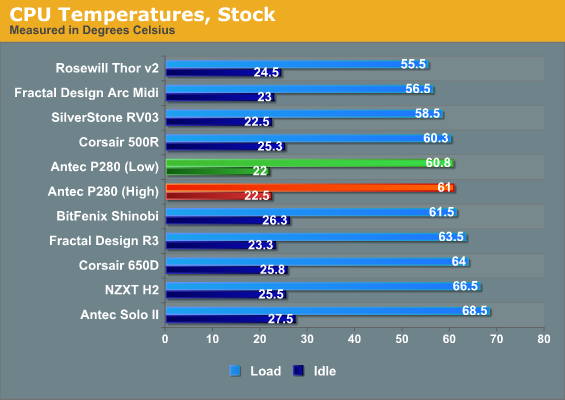
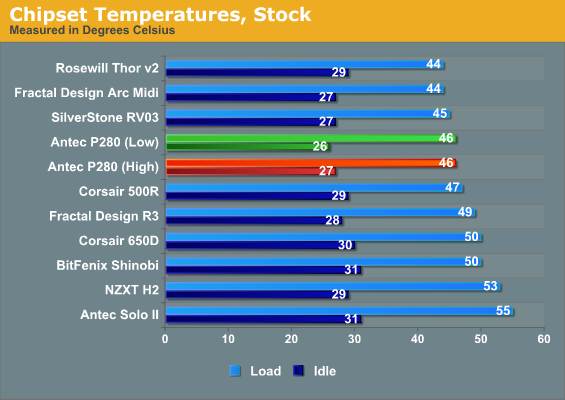
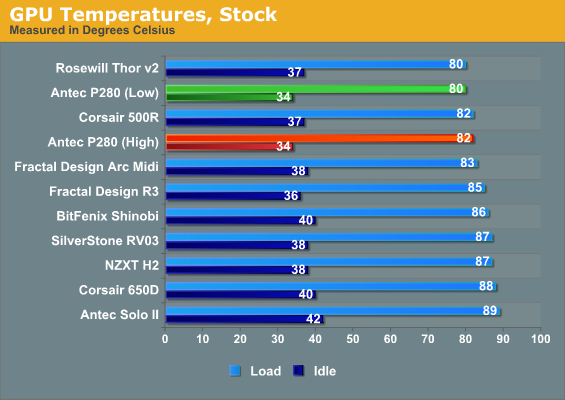
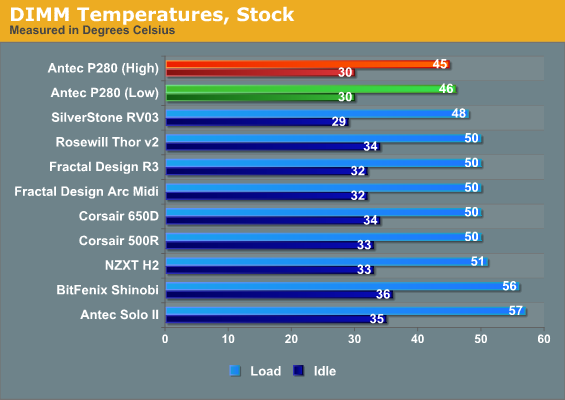

Performance for the P280 is for the most part middle-of-the-road. I think its biggest competitor is probably the up and coming Fractal Design Define R3. What's worth noting is the very minimal impact running the fans at low speeds seems to have had on the enclosure's performance.
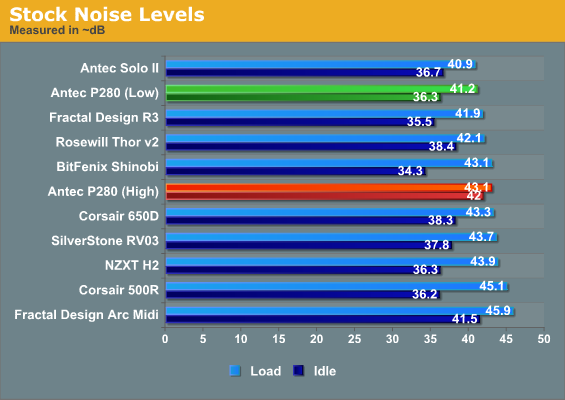
Turning down those fans results in one of the quietest cases we've tested under load, though the results are within the margin of error compared to Fractal Design's Define R3. When we let them ramp up, though, no amount of sound dampening can really save the P280. Thankfully running them at low barely affects thermals, and as a result we get decent performance from a quiet case. So far Antec is on the right track.










164 Comments
View All Comments
TemjinGold - Tuesday, November 15, 2011 - link
I really liked the concept of the P180 Mini because I hate big bulky cases. I will never have more than 2 HDs and 1 SSD and I will never use more than 1 gfx card. I also like uATX motherboards. Any idea if there are plans for a P280 Mini or sorts?danjw - Tuesday, November 15, 2011 - link
I was looking at the product page for the P180 mini a couple weeks ago and that was up said "P183 mini", it has since been changed back. So that suggests they are getting close to a release of an update to it.danjw - Tuesday, November 15, 2011 - link
Opps, just reread this I meant, "... the image that was up ..."albiglan - Tuesday, November 15, 2011 - link
Wasn't there a problem on the P183 that the USB3 connections for the front panel were routed in a "flimsy/cheap" manner? I assume from the lack of coverage on the built in wiring that all is well and good now? Thx for the review! Glad to see Antec is on a better path with this case...haukionkannel - Tuesday, November 15, 2011 - link
It would be nice to see how this new P280 compares to P183. The P280 is easier to assemble, but how about acoustic and temperatures. Are they better or worse in P280?I am happy owner of original P180. It is really a pain in tha ass to assemble, but otherwise very good and quiet case. So it would be nice to see some results of how taking the dual cahmber away has change the things.
tomek1984 - Tuesday, November 15, 2011 - link
I got one of the first versions of P180, and it's still one of my favorite cases today. I never saw any real advantage of the dual chamber but it did help in cleaning big cable cluster. The only problem i had with this case, was trying to install long video card, basically you cant, unless you take out top hard drive cage. So this new design is quite an improvement.My only hope is to see a case which will equal Cooler Master Cosmos 1000 in exterior appearance. It was the first case i had to use a grinder during assembly and the case quality control is not existent ( most screws barely aligned and cable management was completely useless), but that case is second to none in exterior appearance ( together with P180 the only two options i will ever consider in my living room), handle bars also come in very handy when you have to move it around.
Metaluna - Tuesday, November 15, 2011 - link
The main advantage of dual chamber is that you can cool the hard drives using the PSU exhaust fan only (the middle fan is pretty useless unless you've got four 15k rpm SAS drives down there). It also isolates the PSU from the GPU, though you probably get most of that benefit from just having the PSU at the bottom without the partition.That said, I've always hated the removable drive cage down in that chamber. Such a pain to work with.
bobbozzo - Tuesday, November 15, 2011 - link
And mounting spinning drives vertically (in the P180) often is discouraged, forcing one to move the drives to the other bays. I also moved the lower bay fan to the front of the upper drive bay.bigboxes - Tuesday, April 10, 2012 - link
It makes no difference on a drive's orientation. Also, the P183 has removed the fan from the middle. However I added a 120mm in front of the hard drives... all mounted vertically (that's the C: drive and three download drives). The only drive that has died in this case was mounted horizontally in the upper hard drive chamber.http://i256.photobucket.com/albums/hh175/bigboxes/...
8steve8 - Tuesday, November 15, 2011 - link
full size ATX is dead, (or should be)other than graphics, no one buys expansion cards... micro-atx should be the large board for people who want custom features/expansions, and mini-itx should be the mainstream size.
I wish chassis developers would put more effort into smaller sizes.